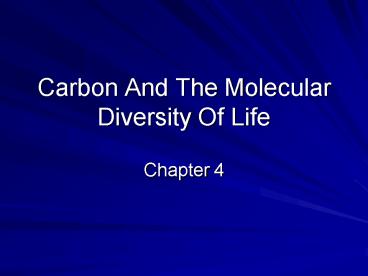Carbon And The Molecular Diversity Of Life - PowerPoint PPT Presentation
1 / 19
Title:
Carbon And The Molecular Diversity Of Life
Description:
Carbon And The Molecular Diversity Of Life. Chapter 4. Vitalism vs. Mechanism. Vitalism is the belief that a life force exists outside of the jurisdiction of ... – PowerPoint PPT presentation
Number of Views:121
Avg rating:3.0/5.0
Title: Carbon And The Molecular Diversity Of Life
1
Carbon And The Molecular Diversity Of Life
- Chapter 4
2
Vitalism vs. Mechanism
- Vitalism is the belief that a life force exists
outside of the jurisdiction of physical and
chemical laws. Therefore, only living things can
make chemicals found in living things. - Mechanism is the belief that living things follow
natural laws, and chemical in living things can
be made in the laboratory. - Laboratory synthesis of urea and acetic acid
helped disprove the Vitalist beliefs.
3
Stanley Miller Re-Creates Life, 1953
4
Millers Experiment
- Stanley Miller, University of Chicago, 1953.
- Tests the abiotic synthesis of organic compounds
by simulating what he thought were the conditions
on Earth before life formed. - Primitive atmosphere containing H2O, NH3, CH4,
H2 (NO OXYGEN) - Energy sources were heat and electric sparks
5
Millers Results
- Spontaneous formation of organic compounds was
possible. - Various organic compounds including many amino
acids were produced in his experiment. - Showed the possibility that life could have
formed, abiotically, on the primitive Earth.
6
Life Based on Carbon
- Electronic configuration 1s22s22p2
- Electron promotion pushes one electron out of the
2s orbital, up into the 2p orbitals - The new configuration is
1s2 2s12px12py12pz1 Four half-filled orbitals
are now available for bonding - Carbon will form four covalent bonds due to sp3
hybridization
7
Other Important Elements
- Hydrogen One covalent bond
- Oxygen Two covalent bonds
- Sulfur Two covalent bonds
- Nitrogen Three covalent bonds
- Phosphorus Three covalent bonds
- Bonds may be single or double for elements
capable of making more than one bond with another
element like carbon
8
Structural IsomersMolecules that have the same
chemical formula but different structure
C4H10
Butane
Isobutane
9
Geometric Isomers Isomers due to different
arrangements about a double-bond
Cis configuration
Trans configuration
10
Enantiomers Optical Isomers
- Non-superimposeable, mirror images.
- Four different groups around a single carbon atom
forms an asymmetric center
11
Functional Groups
- Component part of an organic molecule commonly
involved in chemical rxns - May be non-polar, polar, or charged or
- Seven common functional groups
- Hydroxyl (Alcohol) OH
- Carbonyl O
- Carboxyl C00H (ionized at body pH)
- Amino NH2
- Sulfhydryl SH
- Phosphate PO42- (ionized at body pH)
- Methyl CH4 (Non-polar and hydrophobic)
12
Hydroxyl Group
13
Carbonyl Group
14
Carboxyl Group
15
Amino Group
16
Sulfhydryl
17
Phosphate Group
18
Methyl Group
19
(No Transcript)































